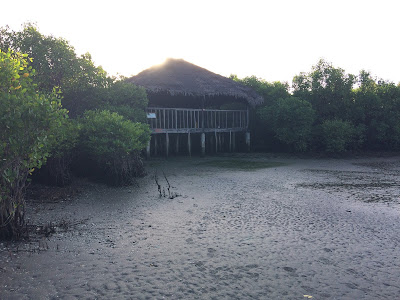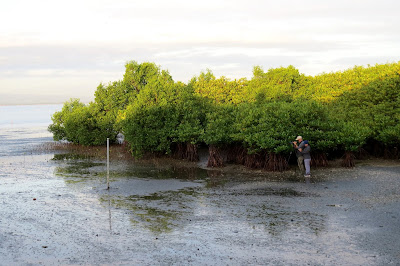The first count I volunteered for gave a surprise sighting that even
made it to the front page of the Philippine Daily Inquirer! I've joined in a
number of bird counts and surveys of Manila Bay with Arne Jensen, the Records
Committee Chair of the Wild Bird Club of the Philippines and an associate
expert of Wetlands International but I've never been to the count site I was
assigned to last January 12. Djop and I were assigned to join the team of Mads
and Lu-Ann Bajarias to count in Sasmuan, Pampanga which included Bangkung
Malapad.
 |
| Boardwalk entrance of SBMCHEA |
As our surroundings became lighter, we were joined by groups of birds skimming the surface of the water around us. It was a such beautiful dawn!
We were soon approaching the entrance to Bangkung Malapad. Bangkung Malapad, also called the Sasmuan Bangkung Malapad Critical Habitat and Ecotourism Area (SBMCHEA) is a small islet in Manila Bay and boasts of mangrove trees and mudflats where migratory birds can be found.
 |
| View from our banca as we approached the entrance to SBMCHEA |
 |
| Walking through the mangroves to the view deck. |
 |
| The trio of Black-faced Spoonbills flying against the pinkish sky |
The spoonbills flew around the view deck a number of times, giving us great views and chances for photographs in our slowly brightening surroundings. We thought (and hoped and prayed) that they would land in the mudflats right in front of us, but sadly they did not and instead flew away behind the mangroves and out of sight.
 |
| That's the view deck as photographed from the mudflats |
 |
| Djop scoping out birds out on the mudflats from the view deck |
 |
| That's Mads and Lu-Ann counting by the mangroves |
 |
| That's me and Djop counting from the mudflats Thank you, Lu-Ann for the photo! =) |
We made our way back to Orani, stopping by a large expanse of exposed mudflats which held quite a big number of plovers. The mud was too wet and mushy for us to stand on for better views, so we took note of the site (no longer in Bulacan) and went back to the fish port. We collated our data over lunch and drove back to the city with a total of more than 9,000 birds for our count. The number was quite low but not bad, plus we had a mega record sighting of the Black-faced Spoonbills too! Black-faced Spoonbills are globally endangered and our sighting last January was the first in more than 100 years since it was last recorded in Manila Bay.
With more and more birders looking at the birds in different areas in Manila Bay, hopefully the efforts to protect and conserve it will pay off. And hopefully, with sightings such as the Black-faced Spoonbills among other birds, there is more than enough justification for the protection of the habitat, not only for the birds and other wildlife, but also for humans too.
Here's a link to the article Lu-Ann wrote for the Philippine Daily Inquirer and republished in WBCP's eBON.



No comments:
Post a Comment